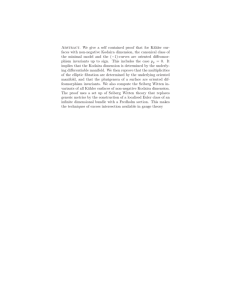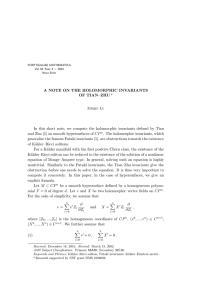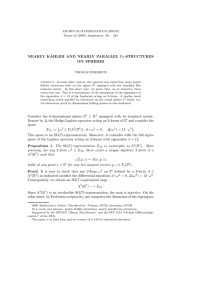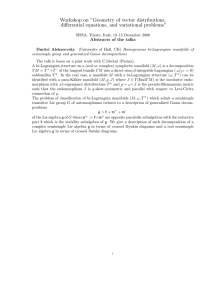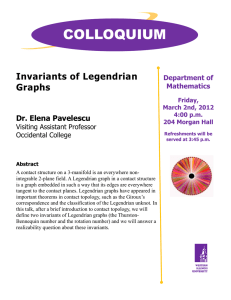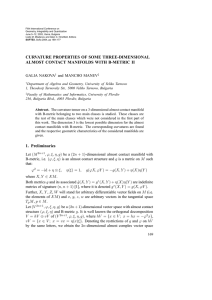Generalisations of Rozansky-Witten invariants Geometry & Topology Monographs Justin Roberts Justin Sawon
advertisement
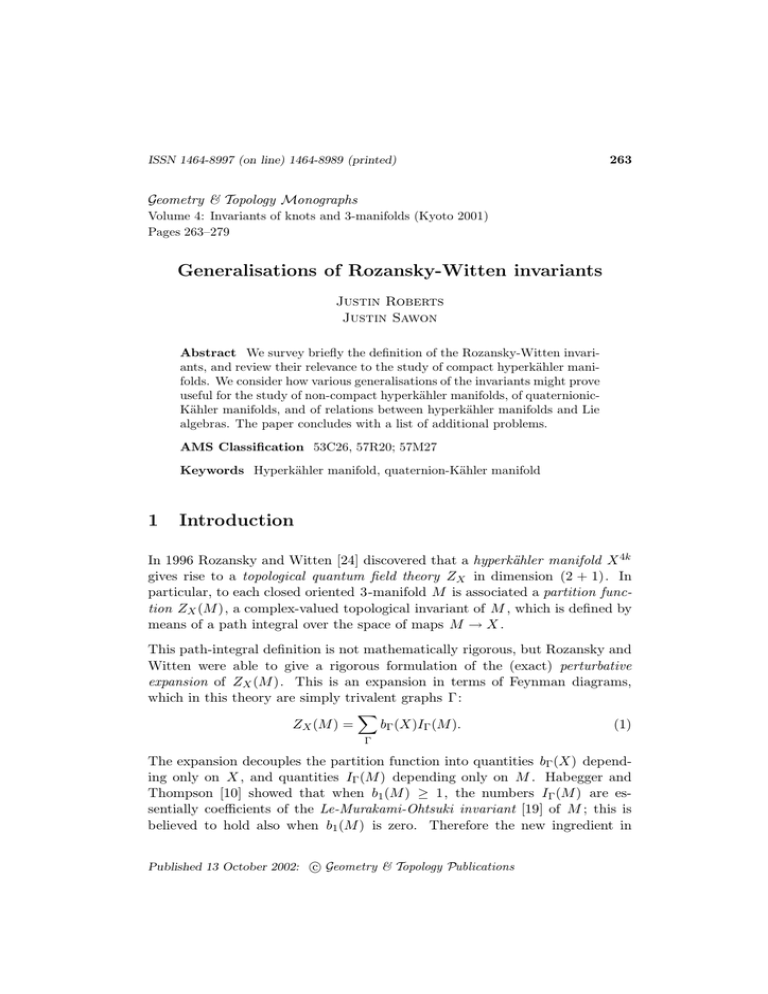
ISSN 1464-8997 (on line) 1464-8989 (printed)
263
Geometry & Topology Monographs
Volume 4: Invariants of knots and 3-manifolds (Kyoto 2001)
Pages 263–279
Generalisations of Rozansky-Witten invariants
Justin Roberts
Justin Sawon
Abstract We survey briefly the definition of the Rozansky-Witten invariants, and review their relevance to the study of compact hyperkähler manifolds. We consider how various generalisations of the invariants might prove
useful for the study of non-compact hyperkähler manifolds, of quaternionicKähler manifolds, and of relations between hyperkähler manifolds and Lie
algebras. The paper concludes with a list of additional problems.
AMS Classification 53C26, 57R20; 57M27
Keywords Hyperkähler manifold, quaternion-Kähler manifold
1
Introduction
In 1996 Rozansky and Witten [24] discovered that a hyperkähler manifold X 4k
gives rise to a topological quantum field theory ZX in dimension (2 + 1). In
particular, to each closed oriented 3-manifold M is associated a partition function ZX (M ), a complex-valued topological invariant of M , which is defined by
means of a path integral over the space of maps M → X .
This path-integral definition is not mathematically rigorous, but Rozansky and
Witten were able to give a rigorous formulation of the (exact) perturbative
expansion of ZX (M ). This is an expansion in terms of Feynman diagrams,
which in this theory are simply trivalent graphs Γ:
X
ZX (M ) =
bΓ (X)IΓ (M ).
(1)
Γ
The expansion decouples the partition function into quantities bΓ (X) depending only on X , and quantities IΓ (M ) depending only on M . Habegger and
Thompson [10] showed that when b1 (M ) ≥ 1, the numbers IΓ (M ) are essentially coefficients of the Le-Murakami-Ohtsuki invariant [19] of M ; this is
believed to hold also when b1 (M ) is zero. Therefore the new ingredient in
c Geometry & Topology Publications
Published 13 October 2002: 264
Justin Roberts and Justin Sawon
Rozansky and Witten’s construction is the weight system bΓ (X), a complexvalued function on trivalent graphs, constructed from the geometry of X .
In this paper we will investigate the weight systems primarily as geometers,
with a view to using them to study the manifold X . Although it is also very
interesting to study the invariants from the point of view of Vassiliev theory
[22], or of TQFT [23], we will not pursue these ideas here.
Let us review the definition of the Rozansky-Witten weight systems, assuming
for the moment that X is compact. Recall that a hyperkähler manifold X 4k is
a Riemannian manifold admitting three orthogonal parallel complex structures
I, J, K which satisfy the quaternion identities. Its holonomy group is contained
in Sp(k), and therefore the frame bundle can be reduced to a principal Sp(k)bundle. The complexification of the tangent bundle therefore splits as a tensor
product
T X ⊗R C = E ⊗C H
(2)
where E is the bundle induced by the standard representation of Sp(k) on
Hk (H denoting the quaternions) and H is a trivialisable complex rank-two
bundle. (This notation is consistent with Salamon’s [25] but differs from that
of Rozansky and Witten [24].)
The Riemann curvature tensor reduces to a section Ψ of Sym4 E , and the
metric induces skew-symmetric two-forms on E and H . Suppose we are given
a trivalent graph Γ with 2k vertices. We place a copy of Ψ at each vertex,
labelling the outgoing edges by the indices of Ψ (with one extra index at each
vertex). Then we tensor these copies of Ψ together, contract indices along edges
using the skew two-form on E , and project the result from ⊗2k E to Λ2k E . The
latter bundle has a trivialisation given by the k th power of the skew two-form,
and hence we obtain a well-defined scalar field which we can integrate over X .
Up to normalization (including orientation conventions to handle the signs) this
gives bΓ (X), an invariant of the hyperkähler structure on X which we will refer
to as a Rozansky-Witten invariant of X .
Rozansky and Witten showed that bΓ (X) depends on the graph Γ only up to
the anti-symmetry and IHX relations, and hence determines a weight system on
the graph homology space of rational linear combinations of equivalence classes
of graphs — that is, the space of Jacobi diagrams typically denoted elsewhere
in these proceedings by A(∅). In particular, this implies that ZX (M ) really is
a topological invariant of M , for the terms IΓ (M ) actually depend on a choice
of metric on M and vary as the metric is deformed, but the variations in the
sum (1) cancel out.
Geometry & Topology Monographs, Volume 4 (2002)
Generalisations of Rozansky-Witten invariants
265
If we choose a complex structure on X which is compatible with the hyperkähler
metric, then the resulting complex manifold has a holomorphic symplectic form
ω ∈ H0 (X, Λ2 T ∗ ), where T ∗ is the holomorphic cotangent bundle. Kontsevich [15] gave a reinterpretation of the weights bΓ (X) using characteristic classes
of the resulting complex-valued symplectic foliation. At the same time Kapranov [13] recognised that from this point of view, the curvature tensor can be
viewed as a Dolbeault representative of the Atiyah class αT of the holomorphic tangent bundle. The Atiyah class αF of a holomorphic bundle F is the
extension class of the short exact sequence
0 → T ∗ ⊗ F → J1 (F ) → F → 0
where J1 (F ) is the first jet bundle of F (see [2]). Thus the Atiyah class αF is
an element of Ext1 (F, T ∗ ⊗ F ) = H1 (X, T ∗ ⊗ End(F )); it vanishes if and only
if the sequence splits, and hence αF is the obstruction to the existence of a
global holomorphic connection on F . We can define the weights bΓ (X) using
the Atiyah class instead of the curvature tensor, with the advantage that we
no longer need to know the metric on X (usually we know only of the existence of a hyperkähler metric, by Yau’s Theorem). This approach required us
to choose a complex structure on X , but we already know from the original
definition that bΓ (X) is independent of this choice, which amounts to a choice
of holomorphic trivialisation of the bundle H , and gives an identification of
E with the holomorphic tangent bundle T . Consequences of this approach
are that Rozansky-Witten invariants are invariant under deformation of the
hyperkähler metric on X , and in fact can be defined more generally for holomorphic symplectic manifolds, which are hyperkähler if and only if they are
Kähler.
The first extensive calculations of Rozansky-Witten invariants were carried out
by the second author in [26]. Let Θk be the (disconnected) graph given by k
copies of the theta graph Θ. If X is an irreducible hyperkähler manifold (i.e.
no covering space of X splits into a product) then bΘk (X) can be written
R
2k kk ( X c2 [ω ω̄]k−1 )k
kRk2k
k!
R
=
(3)
k! ( X [ω ω̄]k )k−1
(4π 2 k)k (vol(X))k−1
where c2 is the second Chern class of T , [ω ω̄] is the cohomology class represented by ω ω̄ , kRk is the L2 -norm of the curvature, and vol(X) is the volume.
(This is equation (10) in [11].) Examples of irreducible hyperkähler manifolds
of dimension 4k are the Hilbert scheme of k points on a K3 surface and the
generalized Kummer varieties (see Beauville [3]).
The Chern numbers of X can also be expressed (see [26]) as Rozansky-Witten
invariants bΓ (X), where we choose Γ to be the closure of a disjoint union of
Geometry & Topology Monographs, Volume 4 (2002)
266
Justin Roberts and Justin Sawon
wheel graphs. Not all graphs can be expressed as a linear combination of such
closures, and indeed Rozansky-Witten invariants are strictly more general than
characteristic numbers (see [27], page 360). However, it is a surprising fact that
Θk can be expressed in such a way: this is a simple corollary of the Wheeling
Theorem of Bar-Natan, Le, and Thurston [31]; a more direct proof was recently
given by Britze and Nieper [5]. We find that
bΘk (X) = 48k k!Â1/2 [X]
(4)
where Â1/2 is the square root of the Â-polynomial. Combining this with the
expression (3) for bΘk (X) gives us a formula (the main result of [11]) for the
L2 -norm of the curvature in terms of characteristic numbers and the volume
of X . This formula was an important ingredient in Huybrechts’ proof [12] of a
finiteness result for the number of diffeomorphism types of compact hyperkähler
manifolds.
There is a useful generalisation [13, 27, 30] of the basic construction. A holomorphic bundle (or coherent sheaf) F on X allows us to define numbers bΓ (X, F )
associated to any trivalent graph Γ which has a preferred oriented circle. This
is the procedure by which one obtains genuine Vassiliev weight systems, defined
on the usual algebra A of Jacobi diagrams.
2
Non-compact hyperkähler manifolds
There are several families of non-compact hyperkähler manifolds X whose
Rozansky-Witten invariants are interesting for physical reasons.
(a) Monopole spaces The story of the invariants actually began with a dimensionally reduced version of Seiberg-Witten theory with gauge group SU(2).
There is a topologically twisted version of this theory which has as its partition
function the Casson invariant, by which we mean the generalisation due to
Walker and Lescop [20] which works for arbitrary 3-manifolds, and not just for
homology spheres. In the low energy limit, the theory becomes a sigma-model
with target space the Atiyah-Hitchin manifold XAH , which is the reduced moduli space of two-monopoles on R3 , and is a smooth non-compact hyperkähler
manifold of dimension four. Rozansky and Witten observed that in fact their
model was still defined with XAH replaced by any (compact or asymptotically
flat) hyperkähler manifold.
There should be versions of the Casson invariant for gauge groups other than
SU(2). For a general group G we should replace XAH by the moduli space
Geometry & Topology Monographs, Volume 4 (2002)
Generalisations of Rozansky-Witten invariants
267
of vacua of the 3-dimensional SUSY gauge theory with gauge group G; for
example, when G is SU(N ) we should choose the target space X to be the
reduced moduli space of N -monopoles. The resulting partition function would
be a finite-type invariant of Ohtsuki order 3(N −1), and it would be particularly
interesting to compute it in the case of SU (3) (perhaps by a surgery formula
- see Thompson [30], for example), and to investigate whether there is any
connection with the generalized Casson invariant of Boden and Herald [4].
(b) Hilbert schemes The (reduced) Hilbert scheme of points on C2 are hyperkähler manifolds whose Rozansky-Witten theory is supposed to arise when
reducing M -theory on manifolds with G2 holonomy to associative submanifolds. Consequently, it would be useful to calculate bΓ (X) for these manifolds.
(c) Gravitational instantons (Kronheimer’s ALE spaces [17]) These spaces
are resolutions of quotient singularities C2 /G, where G is a finite subgroup of
SU(2). The McKay correspondence says that such subgroups correspond to
Dynkin diagrams of type A, D, and E. For example, the cyclic group of order
N corresponds to A N −1 . Kronheimer gave a construction of these spaces as
hyperkähler quotients.
When X is non-compact we encounter a couple of basic problems. Most obviously, the integral in the definition of bΓ (X) may not converge; but even if it
does, we won’t necessarily get a weight system on graph homology, as it may
be necessary to add a boundary term to the IHX relation.
One can always work with weight systems taking graph homology to the Dolbeault cohomology of the manifold, but this might itself be very complicated,
and therefore useless. So let us consider some possible approaches to the convergence problem for the quantities bΓ (X). The first is a direct differential
geometric approach: there are examples of non-compact hyperkähler manifolds
for which the metric is explicitly known, unlike in the compact case. However,
the calculations involved are not simple; see Sethi, Stern, and Zaslow [29] for
this direct calculation when X is the Atiyah-Hitchin manifold. A second approach is to try to mimic Kapranov’s approach, but using compactly supported
(or perhaps L2 ) cohomology. A third approach is to compactify the manifold;
we won’t get a compact hyperkähler manifold but we can at least try to define
Rozansky-Witten invariants of the manifold so obtained.
This third approach has been investigated by Goto [8]. He generalised holomorphic symplectic manifolds by defining log symplectic manifolds as (compact)
complex manifolds having a meromorphic symplectic form with logarithmic
poles along a given divisor D (which must be the anti-canonical divisor). Under certain hypotheses, Rozansky-Witten invariants can be defined for this class
Geometry & Topology Monographs, Volume 4 (2002)
268
Justin Roberts and Justin Sawon
of manifolds. If X is non-compact, we can try to compactify by adding a divisor at infinity. In the case of the reduced monopole moduli spaces this results
in a log symplectic manifold. We don’t yet know whether the (log symplectic)
Rozansky-Witten invariants of this compactification agree with the RozanskyWitten invariants of the non-compact space, as defined in terms of the metric,
but this approach seems highly promising.
The second approach can be illustrated in the case of gravitational instanton
spaces. First note that in four dimensions there is essentially just one RozanskyWitten invariant
Z
1
bΘ (X) =
Tr(R2 )
(2π)2 X
which can be calculated using the Gauss-Bonnet formula. We find
bΘ (X) = 2χ(X) + B(X)
where χ is the Euler characteristic and B is a boundary term. For example,
when X is C2 we have bΘ (C2 ) = 0 and χ(C2 ) = 1, and therefore the boundary
term B(C2 ) must equal −2. Now gravitational instanton spaces are asymptotically locally Euclidean (ALE), which means their metric is asymptotic to the
metric on C2 /G at infinity. In particular, this means they have boundary term
B(X) =
B(C2 )
,
|G|
where |G| is the order of the group G, which acts freely on C2 at infinity.
The homology group H2 (X, Z) is generated by the irreducible curves Ci which
make up the exceptional divisor E , and these correspond to the nodes of the
Dynkin diagram; apart from H0 (X, Z) ∼
= Z, all other homology groups are zero.
Therefore
χ(X) = 1 + rank(G).
Combining the above, we get
bΘ (X) = 2 + 2 rank(G) −
2
.
|G|
In particular, for the A-series we get 2N − N2 . This happens to be twice the
value of the Casimir in the fundamental representation of SU (N ), but we don’t
know a general Lie-theoretic interpretation of the formula.
Now recall that the Atiyah class αT is the obstruction to the existence of a
global holomorphic connection. If we choose a cover {Ui } of X and local
holomorphic connections ∇i on each open set Ui , then the differences
∇i − ∇j ∈ H0 (Ui ∩ Uj , T ∗ ⊗ End(T ))
Geometry & Topology Monographs, Volume 4 (2002)
Generalisations of Rozansky-Witten invariants
269
form a 1-cocycle representing αT in Čech cohomology. Using the ALE property
again, we can choose a holomorphic (in fact flat) connection on the complement
U0 of a compact neighbourhood of the exceptional divisor E . This gives an
Atiyah class which is compactly supported in a neighbourhood of E , and this
Atiyah class can be used to calculate bΘ (X). In the case when X is the A-series
of gravitational instantons, this calculation has been carried out by the second
author and the answer agrees with the one given above.
In general, we don’t expect there to be a compactly supported representative of
the Atiyah class on an arbitrary non-compact hyperkähler manifold X . However, if X is asymptotically flat then there ought to be a representative with
some kind of nice asymptotic behaviour (perhaps lying in L2 -cohomology, for
instance). We are not yet aware of any such examples.
3
Quaternionic-Kähler manifolds
Hyperkähler manifolds can be regarded as particular examples of quaternionicKähler manifolds. Whereas the former have holonomy contained in Sp(k),
quaternionic-Kähler manifolds are characterized by having holonomy contained
in
Sp(k).Sp(1) = Sp(k) × Sp(1)/Z2
where Z2 is generated by (−1, −1). The scalar curvature s of a quaternionicKähler manifold X vanishes if and only if it is locally hyperkähler (in particular, if X is simply connected then s vanishes if and only if X is globally
hyperkähler). However, if s is non-zero then X is not in general Kähler and
does not have a holomorphic symplectic form (indeed it may not even admit
an almost complex structure). Thus at first sight it may appear impossible to
define anything resembling Rozansky-Witten invariants for quaternionic-Kähler
manifolds. Let us assume once again that all our manifolds are compact; our
results on quaternionic-Kähler manifolds will be drawn from Salamon’s survey
article [25].
For a quaternionic-Kähler manifold X there is an obstruction ∈ H2 (X, Z2 )
to the lifting of the structure group Sp(k).Sp(1) of X to Sp(k) × Sp(1). If vanishes then the decomposition (2) of the complexified tangent bundle is still
valid, but with H now a non-trivial rank-two complex vector bundle. Indeed
H is the bundle induced by the standard representation of Sp(1) on H, just as
E is induced by the standard representation of Sp(k) on Hk . More generally,
over open sets where vanishes, there is a local decomposition of this form; for
simplicity we assume vanishes globally.
Geometry & Topology Monographs, Volume 4 (2002)
270
Justin Roberts and Justin Sawon
Let us return to Rozansky and Witten’s original definition of the invariants
using Ψ, the section of Sym4 E . In the quaternionic-Kähler case the curvature
tensor of X equals RQ + sρ1 where RQ is a section of Sym4 E and ρ1 is a
certain invariant element (see [25], Corollary 3.4). We can then proceed as
before using RQ instead of Ψ, and thus define Rozansky-Witten invariants
bΓ (X) for quaternionic-Kähler manifolds X .
There ought to be some interesting consequences to this approach. Since we are
using RQ and not the full curvature tensor, we don’t expect to get characteristic
numbers, as in the hyperkähler case. However, if the scalar curvature s is
of fixed sign, we might generate inequalities between these Rozansky-Witten
invariants and characteristic numbers. For example, it is conjectured that all
positive (i.e. s > 0) quaternionic-Kähler manifolds are symmetric (known as
Wolf spaces), and this has been proved in dimensions 4, 8, and 12. In dimension
12, bounds on the Â-genus play an important role in the proof; it is tempting to
believe that equations like (4), suitably generalised to the quaternionic-Kähler
case, would be useful in tackling the conjecture in higher dimensions.
There is an alternative approach to defining invariants if we wish to stay closer to
authentic characteristic numbers. We first recall some facts about characteristic
classes of quaternionic-Kähler manifolds (see [25], Section 8). Denote by u
minus the second Chern class −c2 (H) of the bundle H . Then u and the Chern
classes of E are well-defined elements of the rational cohomology ring of X
(this is true even when is non-zero). Moreover, 4u is actually integral. From
ch(T X ⊗R C) = ch(E)ch(H)
we see that the first Pontrjagin class of X is
p1 = 2(ku − c2 (E)).
If we look at the left hand side of equation (3) we see that we only need c2 and
the 4-form ω ω̄ to define bΘk (X). Recall that for a hyperkähler manifold the odd
Chern classes vanish and the even Chern classes are equivalent to the Pontrjagin
classes, so we can replace c2 by p1 . On a quaternionic-Kähler manifold X there
is a natural 4-form Ω which is parallel and hence closed. One way to define Ω is
to take local almost-complex structures {I, J, K} behaving like the quaternions
(IJ = K ), and corresponding 2-forms defined by ωI (v, w) = g(Iv, w), etc.
Then
Ω = ωI ∧ ωI + ωJ ∧ ωJ + ωK ∧ ωK
is well-defined up to overall scale, and parallel (even though the local almostcomplex structures and 2-forms are not). Thus in the quaternionic-Kähler case
Geometry & Topology Monographs, Volume 4 (2002)
Generalisations of Rozansky-Witten invariants
271
we can replace ω ω̄ in equation (3) by Ω, and hence define
R
2k kk ( X p1 [Ω]k−1 )k
R
bΘk (X) =
.
k! ( X [Ω]k )k−1
The right hand side is invariant under rescaling of Ω. In fact there is a normalised version of Ω (involving the scalar curvature s) which represents the
cohomology class u, so the definition above is equivalent to
R
2k kk ( X p1 uk−1 )k
R
bΘk (X) =
.
k! ( X uk )k−1
The denominator is known as the quaternionic volume, and is positive.
Clearly this expression is just one of a family of expressions involving integrals
of Pontrjagin classes and the cohomology class u. In the hyperkähler case
(using Chern numbers and [ω ω̄]) all of these expressions are Rozansky-Witten
invariants, though there is no reason to expect that the converse is true. So it
may be that we don’t get a full generalisation of Rozansky-Witten invariants
to quaternionic-Kähler manifolds in this way. Perhaps more importantly, we
no longer have the machinery of graph homology which enabled us to prove
relations such as equation (4).
4
Hyperkähler manifolds and Lie algebras
The primary examples of Vassiliev weight systems are those coming from complex semisimple Lie algebras and superalgebras. It was once conjectured that
in fact all weight systems were of this form, but this was shown to be false by
Vogel [32].
From the point of view of Vassiliev theory, then, the most obvious question
is whether the Rozansky-Witten weight systems are really new, that is, lying
outside the span of the Lie algebraic weight systems. To resolve this issue it
would probably be necessary to understand how the RW weight systems behave
under the action of Vogel’s algebra Λ.
A more general problem is to understand the common properties of hyperkähler
manifolds and Lie algebras. There is in fact an algebraic way to unite them,
described in [22], where it is shown that (roughly) the derived category of coherent sheaves on X 4n is the category of modules over the holomorphic tangent
sheaf T , which is a Lie algebra in this category. Thus, a hyperkähler manifold
can be thought of as giving rise to a Lie algebra – but not in the usual category
of vector spaces.
Geometry & Topology Monographs, Volume 4 (2002)
272
Justin Roberts and Justin Sawon
Studying the analogy between the derived category and a representation category seems fruitful. There are similiarities: the derived category possesses a
Duflo isomorphism, namely “theorem of the M. Kontsevich on complex manifold” [16]. But there are also basic differences: the derived category is not
semisimple. It would be interesting to study whether there are analogues of
Adams operations, character formulae, Harish-Chandra isomorphisms, etc. in
the derived category; whether there are classes of sheaves (exceptional, stable,
etc.) or bundles which behave like irreducible objects; and whether there is a
meaningful interpretation of the “quantum dimensions” of sheaves arising from
the Rozansky-Witten partition function of the unknot.
In the converse direction, is it possible to realise the Lie algebraic weight systems
as the Rozansky-Witten invariants of suitable hyperkähler manifolds? These
would presumably have to be infinite-dimensional manifolds, because a Lie
algebra defines weight systems in all degrees, whereas a manifold X 4k defines
weight systems only in degree less than or equal to k . A potentially useful
observation is that the based loop space ΩGC of a complex semisimple Lie
group is a hyperkähler manifold; the idea to look at the loop space (or perhaps
the classifying space BG) is also suggested by Kontsevich’s description [15] of
a “shifted” Lie algebra as a formal symplectic manifold. The formal shift in
grading is closely related to the shift used in forming the bar complex to obtain
a model of the cohomology of the loop space.
Returning again to gravitational instantons, we have seen a tiny piece of numerical evidence suggesting that the invariants bΓ (X) corresponding to these
spaces should be related to the weight systems of the corresponding Lie algebras (i.e. of types A, D, and E). Of course the ALE spaces are four-dimensional
and so there is only one invariant bΘ (X); to obtain invariants in all degrees
we would need to consider also the Hilbert schemes of points on X , or more
generally moduli spaces of instantons on X . These spaces can also be obtained
by the hyperkähler quotient construction: see Kronheimer and Nakajima [18].
A slightly different way to look for connections between hyperkähler manifolds
and Lie algebras is to work in terms of the associated TQFTs, rather than just
weight systems. Each TQFT is determined by an underlying ribbon category C .
In Witten’s Chern-Simons theory [33], C is the category of representations of a
quantum group at a root of unity (see Reshetikhin and Turaev [21]), whereas in
Rozansky-Witten theory we find [23] that C is essentially the derived category of
coherent sheaves on X , with a non-standard ribbon category structure. Might
there then be a manifold whose derived category is one of these representation
categories? This seems somewhat outrageous, because one would not expect the
derived categories to be semisimple, or even abelian. One could at least hope
Geometry & Topology Monographs, Volume 4 (2002)
273
Generalisations of Rozansky-Witten invariants
for some extension of the work of Kapranov and Vasserot [14], who described
the derived category of the ALE spaces in purely algebraic terms. Note also
that Freed, Hopkins and Teleman [7] have shown that the representation ring
(Verlinde algebra) of the quantum group appears geometrically as a twisted K group; it is tempting to wonder whether the underlying representation category
might not arise as some kind of underlying twisted derived category of sheaves
(such things have been defined by Caldararu [6]).
A totally different approach to connecting the two worlds would be to define a
theory of equivariant Rozansky-Witten invariants, in which the G-equivariant
invariants of a point give rise to Lie algebra weight systems. Quite what properties such a theory should have is unclear: it should perhaps be related more
to the hyperkähler quotient construction than to the usual homotopy quotient
underlying equivariant cohomology.
5
Further problems
Problem 1 Derive new constraints of the form (4) for hyperkähler manifolds.
Remarks We hope that the existence of the TQFT structure, which allows
the computation of partition functions in many different ways, will yield new
identities involving the characteristic classes of hyperkähler manifolds. It would
be particularly useful to give a formula for the norm of the curvature of a general
holomorphic bundle, bounding the Chern numbers of such bundles on X .
Problem 2 Are the invariants bΓ (X) rational, or even integral?
Remarks Current evidence suggests that, correctly normalised, the weight
systems for compact hyperkähler manifolds take integral values on trivalent
diagrams, and are at least rational for non-compact manifolds. Might the integrality be a consequence of an alternative, enumerative-geometric “counting”
definition of the invariants?
1
Problem 3 What is the meaning of the  2 -genus of a manifold?
1
Remarks This genus appears in the identity (4). The  2 -class appears also
in Kontsevich’s Duflo isomorphism for complex manifolds, and in physics, in
the study of D-brane charge [1]. One would assume that these occurrences are
somehow related. Is there some natural class of manifolds for which the genus
Geometry & Topology Monographs, Volume 4 (2002)
274
Justin Roberts and Justin Sawon
is integral? In other words, might it be the index of an elliptic operator which
can only be defined under certain geometrical conditions? (It is not actually
integral for hyperkähler manifolds — see [26].)
Problem 4 What is the relation between RW invariants and Chern numbers?
Remarks We can consider various classes of invariants, each a generalisation
of the previous one: linear combinations of honest Chern numbers; generalised
Chern numbers involving powers of the symplectic form and its conjugate; RW
invariants; “big Chern classes” [13]. The linear combinations of Chern numbers
are contained in rational functions of Chern numbers, which are determined
by the Chern classes. Which of these inclusions is strict? Are there other
interesting ones?
Problem 5 Explain the “characteristic numbers” of non-compact examples.
Remarks The partition functions ZX (S 1 × S 2 ) and ZX (S 1 × S 1 × S 1 ) are,
for any TQFT, the dimensions of certain vector spaces, and hence integral.
In RW theory on a compact manifold X , they are the Todd genus and Euler
characteristic of X , respectively. For non-compact X they seem to be rational:
1
for example ZXAH (S 1 × S 2 ) = − 12
according to Rozansky and Witten (at least
up to sign, about which there are some difficulties). Might such numbers in
fact be the regularised dimensions of infinite-dimensional vector spaces?
Problem 6 Sen’s conjecture on the cohomology of monopole spaces.
Remarks The monopole space, mentioned earlier, can also be described as a
certain space of rational functions on the Riemann sphere. The Sen conjecture
(see [28]) makes certain predictions about the L2 -cohomology of this space, in
particular that there is a certain SL(2, Z) action on it. Might this action be
derivable from TQFT?
Problem 7 Define RW invariants for singular hyperkähler manifolds.
Remarks It might be helpful to be able to handle orbifolds, in order to better
understand the behaviour of RW invariants of hyperkähler quotients and quotients by finite groups. If the equivariant theory goes through, might there be
localisation formulae for the curvature integrals?
Problem 8 Compute the invariants for some non-Kähler holomorphic symplectic manifolds.
Geometry & Topology Monographs, Volume 4 (2002)
Generalisations of Rozansky-Witten invariants
275
Remarks It would be interesting to calculate RW invariants for non-Kähler
holomorphic symplectic manifolds, such as Douady spaces of the Kodaira surface (in fact the invariants are zero for these) or Guan’s examples [9], and to
try to work out whether such invariants are independent of choice (if any) of
complex structure.
Problem 9 Try to extend the invariants to other holonomy groups.
Remarks Why stop with quaternionic-Kähler manifolds? If we take the viewpoint that Rozansky-Witten invariants are special characteristic classes arising
out of a reduction of structure group on a Riemannian manifold, then it is
natural to try to find analogues for all special holonomy groups.
Here is the idea. First examine the symmetries of the curvature tensor and
decide what kind of graphical vertex it corresponds to. Decide on what kind
of graphs index the possible self-combinations of the curvature and the other
special structural forms (e.g. on a G2 -manifold, the canonical 3- and 4-forms.)
Then attempt to compute the universal graphical relations amongst such combinations; that is, find out what kind of graph homology is appropriate.
For example, on any Kähler manifold (holonomy U (k)) one is free to use trivalent trees to combine the curvature with itself, and the IHX relation is satisfied
in cohomology. This is part of Kapranov’s L∞ structure. Graphs with one
loop can be created by taking trace, but to glue up more legs would require a
bilinear form, as in the holomorphic symplectic case. On a Calabi-Yau manifold
(holonomy SU (k)) there is a canonical volume form, which would be pictured
as a k -valent vertex. Whether or not the appropriate graph complex is ever
rich enough to be useful, we do not know.
Problem 10 Prove that S 6 is not complex.
Remarks It is a famous problem to show that the 6-sphere, though almostcomplex, has no (integrable) complex structure. Perhaps the L∞ structure on
the Dolbeault complex of a complex manifold (due to Kapranov, and a basic
ingredient in RW theory) might provide a new approach to a contradiction.
Problem 11 Explore Kontsevich’s generalisation of the theory.
Remarks Kontsevich gave a tremendous generalisation of the RW formalism, taking in foliated real manifolds with a transverse symplectic form, and
in particular flat symplectic fibre bundles. This construction is completely unexplored; perhaps a sheaf-theoretic approach could help in calculating some
examples, starting with the case of surface bundles over surfaces.
Geometry & Topology Monographs, Volume 4 (2002)
276
Justin Roberts and Justin Sawon
Problem 12 Investigate the use of higher graph cohomology.
Remarks Kapranov’s L∞ structure allows the construction of weight systems
in higher graph cohomology, that is, numerical evaluations of graphs with vertices of valence bigger than three. Little is known about the graph homology
spaces in positive degree, primarily because the usual Lie algebraic methods are
useless for studying them.
Problem 13 Investigate the functoriality of RW invariants.
Remarks In contrast to the usual theory of characteristic classes, the RW
theory does not have a theory of classifying spaces, unless one uses Kontsevich’s
Gelfand-Fuchs cohomology framework. A basic problem is that hyperkähler
manifolds don’t form a reasonable category (there are almost no morphisms),
and so comparing the invariants of different manifolds is very hard. Is there
any way to get around this?
Problem 14 Compare Chern-Simons theory and RW theory as sigma-models.
Remarks Chern-Simons theory is a TQFT defined by Witten [33] whose partition function is given by an integral over the space of all connections on the
trivial principal G-bundle over a 3-manifold. Such connections can be thought
of as pullbacks of the universal connection on the bundle EG → BG via smooth
maps M → BG, and so in these terms CS theory resembles the RW theory with
X = BG (compare this with the remarks in section 4 about the loop space).
The CS integrand can be defined by extending the map M → BG over a 4manifold W whose boundary is M , and computing the integral over W of the
pullback of the fundamental (Pontrjagin) 4-form on BG. In the RW case one
could try to do something similar, at least for a null-homologous M → X , by
using the fundamental 4-form ω ω̄ . Can these analogies be made more precise,
and if so is there a fruitful exchange of techniques?
Problem 15 What are the trajectories of the RW action functional?
Remarks In Chern-Simons theory, the action functional can be viewed as a
Morse function on the space of G-connections on the 3-manifold M . Its critical
points are the flat connections, and the gradient flow lines (corresponding to
instantons on M × R) can be used to define the Floer homology of M . In RW
theory, the action functional is defined on smooth maps φ : M 3 → X , and its
stationary points are the constant maps. Can one make sense of the trajectories
of the functional, thought of as maps : M × R → X , and does this lead to a
Floer homology of some kind?
Geometry & Topology Monographs, Volume 4 (2002)
Generalisations of Rozansky-Witten invariants
277
Problem 16 Can RW weight systems detect orientation?
Remarks There are many problems on the subject of the RW TQFT, and its
interaction with the theories of Vassiliev and quantum invariants. These will
be addressed elsewhere [23], but perhaps the most straightforward is as follows.
The Vassiliev algebra A has an involution induced by reversing orientations
of the preferred circles of all spanning diagrams. An open question is whether
this involution is the identity or not; equivalently, whether Vassiliev invariants
cannot (or can) detect the orientation of knots. Weight systems arising from Lie
algebras are incapable of distinguishing between diagrams and their reverses,
but it is not at all clear how to prove that RW weight systems share this
property. Thus it is conceivable that they could be used to find non-reversible
diagrams, if indeed such things exist.
Acknowledgements The first author was supported by NSF Grant DMS0103922 and JSPS fellowship S-01037; the second by New College, Oxford and
by RIMS. We thank the organisers very much for our invitations to RIMS and
for their hard work in setting up such a stimulating and enjoyable conference.
References
[1] P Aspinwall, A Lawrence, Derived categories and zero-brane stability, J.
High Energy Phys. 8 (2001) 4:27
[2] M F Atiyah, Complex analytic connections in fibre bundles, Trans. Am. Math.
Soc. 85 (1957) 181–207
[3] A Beauville, Variétés Kählériennes dont la 1ére classe de Chern est nulle,
Jour. Diff. Geom. 18 (1983) 755–782
[4] H U Boden, C Herald, The SU (3) Casson invariant for integral homology
3-spheres, J. Differential Geom. 50 (1998) 147–206
[5] M Britze, M A Nieper, Hirzebruch-Riemann-Roch formulae on irreducible
symplectic Kähler manifolds, arXiv:math.AG/0101062
[6] A Caldararu, Derived categories of twisted sheaves on Calabi-Yau manifolds,
Ph.D. thesis, Cornell University (2000)
[7] D S Freed, M Hopkins, C Teleman, in preparation
[8] R Goto, Rozansky-Witten invariants of log symplectic manifolds, from: “Integrable systems, topology, and physics (Tokyo, 2000)”, Contemp. Math. 309,
Amer. Math. Soc. Providence, RI (2002) 69–84
[9] D Guan Examples of compact holomorphic symplectic manifolds which are not
Kählerian. II, Invent. Math. 121 (1995) 135–145
Geometry & Topology Monographs, Volume 4 (2002)
278
Justin Roberts and Justin Sawon
[10] N Habegger, G Thompson, The universal perturbative quantum 3-manifold
invariant, Rozansky-Witten invariants, and the generalized Casson invariant,
preprint (1999)
[11] N Hitchin, J Sawon, Curvature and characteristic numbers of hyperkähler
manifolds, Duke Math. Journal 106 (2001) 599–615
[12] D Huybrechts, Finiteness results for hyperkähler manifolds, Reine Angew.
Math. 558 (2003) 15–22
[13] M M Kapranov, Rozansky-Witten invariants via Atiyah classes, Compositio
Math. 115 (1999) 71–113
[14] M M Kapranov, E Vasserot, Kleinian singularities, derived categories and
Hall algebras, Math. Ann. 316 (2000) 565–576
[15] M Kontsevich, Rozansky-Witten invariants via formal geometry, Compositio
Math. 115 (1999) 115–127
[16] M Kontsevich, Deformation quantization of Poisson manifolds I, preprint
arXiv:q-alg/9709040
[17] P B Kronheimer, The construction of ALE spaces as hyperkähler quotients,
Jour. Diff. Geom. 29 (1989) 665–683
[18] P B Kronheimer, H Nakajima, Yang-Mills instantons on ALE gravitational
instantons, Math. Ann. 288 (1990) 263–307
[19] T T Q Le, J Murakami, T Ohtsuki, On a universal perturbative invariant
of 3-manifolds, Topology 37 (1998) 539–574
[20] C Lescop, Global surgery formula for the Casson-Walker invariant, Annals of
Mathematical Studies 140, Princeton University Press (1996)
[21] N Y Reshetikhin, V G Turaev, Invariants of 3-manifolds via link polynomials and quantum groups, Invent. Math. 103 (1991) 547–597
[22] J D Roberts, S Willerton, On the Rozansky-Witten weight systems, in preparation
[23] J D Roberts, J Sawon, S Willerton, On the Rozansky-Witten TQFT, in
preparation
[24] L Rozansky, E Witten, Hyperkähler geometry and invariants of threemanifolds, Selecta Math. 3 (1997) 401–458
[25] S M Salamon, Quaternion-Kähler geometry, Surveys in differential geometry
VI: essays on Einstein manifolds, International Press (1999) 83–121
[26] J Sawon, Rozansky-Witten invariants of hyperkähler manifolds, PhD thesis,
University of Cambridge (1999), www.math.sunysb.edu/~sawon
[27] J Sawon, A new weight system on chord diagrams via hyperkähler geometry,
Proceedings of the Second Meeting on Quaternionic Structures in Mathematics
and Physics, Rome 6–10 September 1999, World Scientific (2001) 349–363
Geometry & Topology Monographs, Volume 4 (2002)
Generalisations of Rozansky-Witten invariants
279
[28] G B Segal, A Selby, The cohomology of the space of magnetic monopoles,
Commun. Math. Phys. 177 (1996) 775–787
[29] S Sethi, M Stern, E Zaslow, Monopole and dyon bound states in N = 2
supersymmetric Yang-Mills theories, Nuclear Phys. B 457 (1995) 484–510
[30] G Thompson, On the generalized Casson invariant, Adv. Theor. Math. Phys.
3 (1999) 249–280
[31] D P Thurston, Wheeling: A diagrammatic analogue of the Duflo isomorphism,
PhD thesis, UC Berkeley (2000), arXiv:math.QA/0006083
[32] P Vogel, Algebraic structures on modules of diagrams, preprint (1995)
[33] E Witten, Quantum field theory and the Jones polynomial, Comm. Math. Phys.
121 (1989) 351–399
Department of Mathematics, UC San Diego
9500 Gilman Drive,La Jolla, CA 92093, USA
and
Mathematical Institute, 24-29 St Giles’
Oxford OX1 3BN, UK
Email: justin@euclid.ucsd.edu, sawon@math.sunysb.edu
URL: www.math.ucsd.edu/~justin, www.math.sunysb.edu/~sawon
Received: 3 December 2001
Revised: 1 April 2002
Geometry & Topology Monographs, Volume 4 (2002)
